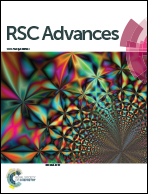Layer-by-layer surface decoration of electrospun nanofibrous meshes for air–liquid interface cultivation of epidermal cells†
Abstract
Multilayered assembly of hydrophilic polymers is used to decorate electrospun nanofibrous mats for the air–liquid interface cultivation of epidermal cells. ε-Caprolactone is ring-opening polymerized into carboxyl-terminated poly(ε-caprolactone) (PCL) and subsequently conjugated with poly(ethyleneimine) (PEI) in order to prepare the PCL–PEI block copolymers. The electrospun PCL–PEI nanofibers are chemically conjugated with multivalent poly(ethyeleneglycol) (PEG) chains, and PEI is chemically tethered to the PEG layers in order to further decorate the surface with multiple layers of PEG. The layered PEG is characterized using both thermal properties and direct visualization of the whole mats with fluorescence labeling, which exhibit escalating levels of PEG content with increasing numbers of PEG layering processes. The PCL–PEI nanofibers with PEG multilayers exhibit superior water swelling rates compared with unmodified mats and have high water retaining behaviors for prolonged periods without additional water supply in a PEG layer-dependent manner. When epidermal cells are cultivated on the PEG-multilayered mats without a continuous supply of the cell culture medium, the viability is maintained for 48 h and gradually decreases after 48 h. The epidermis-specific genes are highly expressed in cells cultivated on the PEG-multilayered mats in comparison with those on an insert well or unmodified mats, which is confirmed by qualitative real-time polymerase chain reaction and immunocytochemical staining of total keratin. Thus, PEG-multilayered nanofibrous mats can be a novel cell culture matrix for cell culture systems where the cell cultivation conditions require air–liquid interfaces.


 Please wait while we load your content...
Please wait while we load your content...